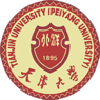Tianjin Life
With the closest seaport 80 kilometers (50 miles) southeast of Beijing, Tianjin is Beijing's gateway to the open sea, covering an area of 11 thousand square kilometers. The city's streetscapes consist of 19th and 20th century European architecture, juxtaposed with concrete and glass monoliths of wealthy contemporary China. People enjoy the colonial buildings while the city has drastically modernized; now requiring a new map to be printed every three months. It is a great place for people wishing to live and study near Beijing, yet desiring a more off the beaten path destination.
Tianjin used to be a military fortress, and in peacetime became an agricultural town. Its military men thus became farmers. Tianjin's economy remained agricultural for over 200 years until the 1860s, when the city was made a treaty port after China's defeat by the British-French allied forces. It later developed a navigation economy and became a trading center in northern China, to which merchants from across the country traveled. After China began to open up in the late 1970s, Tianjin has seen rapid development, though it is now lagging behind other important cities like Shanghai, Beijing, and Guangzhou.
Covering an area of 11 thousand square kilometers, Tianjin Municipality is generally flat and swampy near the coast, but hilly in the far north, where the Yanshan Mountains pass through the tip of northern Tianjin. The highest point in Tianjin is Jiushanding Peak on the northern border with Hebei, at an altitude of 1078 meters. Major reservoirs include the Beidagang Reservoir in the extreme south (in Dagang District) and the Yuqiao Reservoir in the extreme north of Ji County.
Farmland takes up about 40% of Tianjin Municipality's total area. Wheat, rice, and maize are the most important crops. Fishing is important along the coast. Tianjin is also an important industrial base. Major industries include petrochemical industries, textiles, car manufacturing, mechanical industries, and metalworking. The Tianjin Auto Works produces 150,000 cars a year. Tianjin has deposits of about 1 billion tonnes of petroleum, with Dagang District containing important oilfields. Salt production is also important, with Changlu Yanqu being one of China's most important salt production areas. Geothermal energy is another resource of Tianjin. Deposits of manganese and boron under Tianjin were the first to be found in China.
Living in Tianjin provides the perfect escape from being in the capital without going too far. However, Chinese industries also had the same notion; moving all the heavy industries out of the capital and into a neighboring town allows businesses to flourish without the heavy tax penalty. Therefore Tianjin tends to be just as crowded as Beijing. On the other hand, government has made it a goal to clean up Tianjin's environment, providing locals a new breath of fresh air. |

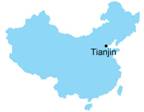 Tianjin
is one of the four municipalities of China. As a municipality, Tianjin has
provincial-level status and comes directly under the central government. Tianjin's
urban area, located along the Haihe River, is the third largest city in China
behind Shanghai and Beijing. Its ports, some distance away, are located on
Bohai Gulf in the Pacific Ocean. Tianjin Municipality borders Hebei province
to the north, south, and west; the municipality of Beijing is to the northwest
and Bohai Gulf to the east.
Tianjin
is one of the four municipalities of China. As a municipality, Tianjin has
provincial-level status and comes directly under the central government. Tianjin's
urban area, located along the Haihe River, is the third largest city in China
behind Shanghai and Beijing. Its ports, some distance away, are located on
Bohai Gulf in the Pacific Ocean. Tianjin Municipality borders Hebei province
to the north, south, and west; the municipality of Beijing is to the northwest
and Bohai Gulf to the east. 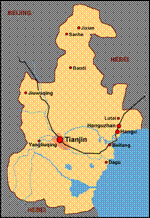 Tianjin's history is short by Chinese standards, only a mere 600 years or
so. The opening of the Grand Canal of China during the Sui Dynasty prompted
the development of Tianjin into a trading center. Until 1404 Tianjin was called "Zhigu",
or "Straight Port". In that year, the Emperor Yongle renamed the
city "Tianjin", literally "Heaven Ford", to mean that the
emperor (son of heaven) forded the river at that point. And then a fort was
established in Tianjin, known as "Tianjin Wei", meaning "Fort
Tianjin".
Tianjin's history is short by Chinese standards, only a mere 600 years or
so. The opening of the Grand Canal of China during the Sui Dynasty prompted
the development of Tianjin into a trading center. Until 1404 Tianjin was called "Zhigu",
or "Straight Port". In that year, the Emperor Yongle renamed the
city "Tianjin", literally "Heaven Ford", to mean that the
emperor (son of heaven) forded the river at that point. And then a fort was
established in Tianjin, known as "Tianjin Wei", meaning "Fort
Tianjin".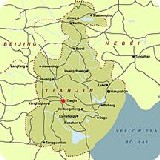 Tianjin is located from 38o34' to 40o15' north latitude and from 116o43' to
118o04' east longitude, in the lower reach of Haihe River. Tianjin is at the
northern end of the Grand Canal of China, which connects with the Huang He
and Yangtze rivers. Whereas Tianjin's urban area is located along the Haihe
River, its ports are located on the Bohai Gulf of the Pacific Ocean. The Tianjin
Municipality borders the Hebei province to the north, south, and west; the
municipality of Beijing in a small portion to the northwest; and Bohai Gulf
to the east.
Tianjin is located from 38o34' to 40o15' north latitude and from 116o43' to
118o04' east longitude, in the lower reach of Haihe River. Tianjin is at the
northern end of the Grand Canal of China, which connects with the Huang He
and Yangtze rivers. Whereas Tianjin's urban area is located along the Haihe
River, its ports are located on the Bohai Gulf of the Pacific Ocean. The Tianjin
Municipality borders the Hebei province to the north, south, and west; the
municipality of Beijing in a small portion to the northwest; and Bohai Gulf
to the east.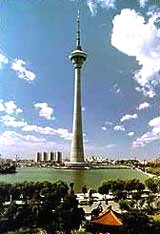 Tianjin is an industrial, commercial, and financial center. It has substantial
mineral reserves and produces one-third of the country's sea-salt. It boasts
lower land, labor, and operating costs than Beijing, Shanghai, and Guangdong.
Tianjin has already achieved successes in the operation of its Economic and
Technological Development Zone in the northeastern part of Tanggu District.
Tianjin is an industrial, commercial, and financial center. It has substantial
mineral reserves and produces one-third of the country's sea-salt. It boasts
lower land, labor, and operating costs than Beijing, Shanghai, and Guangdong.
Tianjin has already achieved successes in the operation of its Economic and
Technological Development Zone in the northeastern part of Tanggu District. 